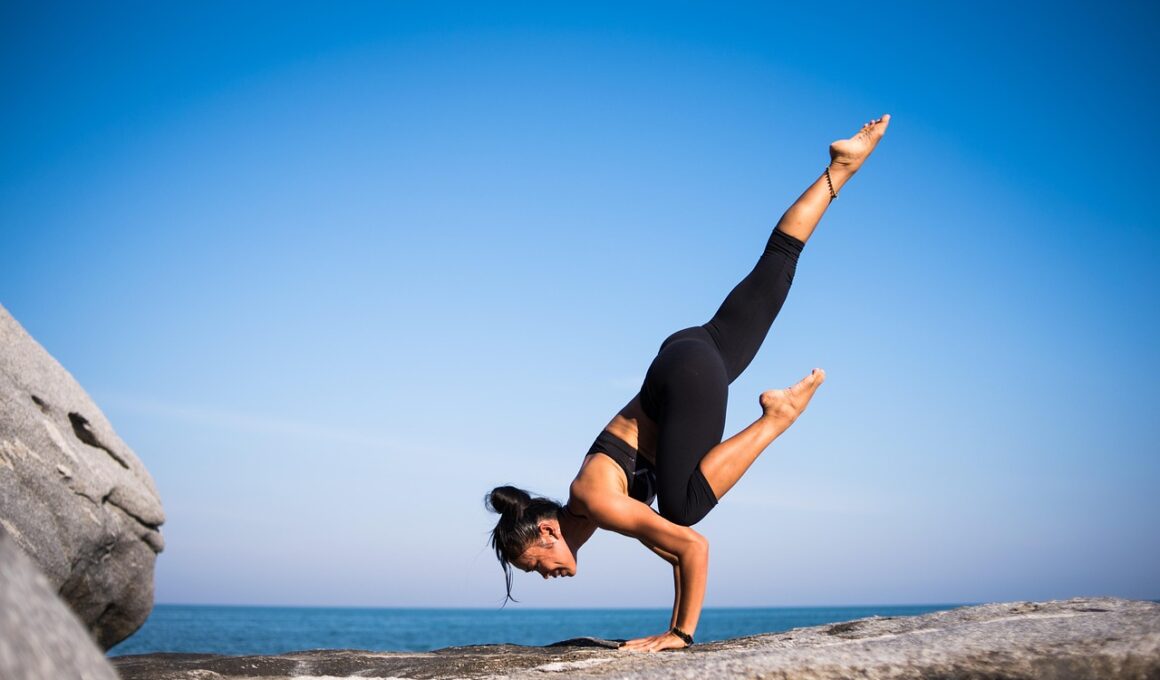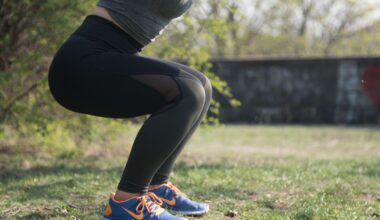The Relationship Between Flexibility and Balance
Flexibility and balance are two critical components of physical fitness that often interconnect. Flexibility refers to the range of motion available in joints and muscles, whereas balance is the ability to maintain bodily equilibrium. These two attributes significantly impact each other, wherein improved flexibility can enhance balance, ultimately leading to better overall performance in various physical activities. For instance, a broader range of motion in the hips can help individuals maintain their center of gravity, reducing the chances of falls, especially in older adults. Furthermore, specific stretches targeting the legs, back, and arms can promote better body awareness, contributing to enhanced balance. To cultivate flexibility, a consistent routine of stretching exercises is recommended that focuses on major muscle groups, incorporating both static and dynamic stretches. Notably, yoga can serve as an effective practice to combine flexibility improvement with balance training. Increase your commitment to flexibility exercises to witness the gradual enhancement in balance and coordination. Overall, cultivating both flexibility and balance should be core facets of fitness routines for individuals of all ages striving for optimal health.
Improving flexibility has direct implications on balance, particularly for athletes and physically active individuals. When athletes possess greater flexibility, it allows the body to move more freely and adapt to changing positions, which is essential in sports such as gymnastics, dance, or martial arts. Each of these disciplines demands a unique combination of flexibility and balance to execute movements effectively and maintain control. Strengthening the core muscles also supports both flexibility and balance, providing stability and reducing the risk of injury. Core workouts that enhance stability can be synchronized with flexibility routines for maximum effectiveness. In turn, improved balance helps prevent accidents, creates more fluid movements, and ultimately enhances athletic performance. Incorporating exercises like standing leg lifts, balance boards, and dynamic stretches can contribute to achieving this synergy. Engaging in regular practice not only increases balance but also encourages better posture, which plays a crucial role in overall body alignment. Athletes and fitness enthusiasts who prioritize flexibility, alongside targeted strength training, will likely experience heightened physical capabilities and reduced risk for injuries resulting from falls or missteps.
The Role of Stretching in Enhancing Balance
Stretching is a fundamental practice that plays a vital role in enhancing balance alongside flexibility. This practice consists of various techniques that elongate muscle fibers and connective tissues, leading to improved elasticity in these structures. While often perceived purely as a warm-up, stretching should be considered an integral part of any physical regimen and can be performed before, during, and after workouts. Dynamic stretching prepares the body for movement, while static stretching aids in recovery, increasing muscle length and mobility over time. Certain stretches not only promote flexibility but also have a direct impact on balance by enhancing proprioception, which is the body’s ability to sense its position in space. By integrating stretches that target specific muscle groups, individuals can foster better coordination between their muscle and nerve systems. Incorporating balance-centric stretches, like those performed on one leg or with the use of stability aids, can significantly improve overall coordination. Over time, consistent stretching leads to better muscle control and steadiness, ultimately benefiting everyday activities such as walking, running, or participating in sports.
For dancers, yoga practitioners, and gymnasts, the interplay between flexibility and balance is even more pronounced. These activities necessitate precision and grace, aspects heavily influenced by one’s flexibility level. Many movements within these disciplines require extreme ranges of motion, where flexibility not only allows for execution but also contributes to the aesthetics of the performance. Regular training focused on both flexibility and balance can help enhance these qualities, consequently boosting confidence and reducing performance anxiety. Cross-training with other activities like swimming or cycling can provide additional conditioning while keeping the practice dynamic and engaging. Engaging in diverse workouts can prevent monotony, encouraging sustained participation and yielding better fitness results. Resistance training can also complement flexibility routines, targeting muscle strength while not compromising flexibility. Additionally, group classes that espouse concepts of flexibility, balance, and strength can foster social engagement, encouraging a supportive environment that motivates individuals. As one progresses on their journey towards enhanced flexibility and balance, they will likely experience significant benefits across all physical disciplines, ultimately contributing to a more fulfilling and health-conscious lifestyle.
Flexibility in Rehabilitation and Recovery
Flexibility is crucial not only for athletic performance but also for injury recovery and rehabilitation processes. After sustaining an injury, restoring flexibility is paramount for proper healing and muscle recovery. Physical therapists often incorporate stretching exercises into rehabilitation protocols to promote blood flow, reduce stiffness, and enhance muscle function. Embedding flexibility training within rehabilitation programs translates to improved performance post-injury and can reduce the likelihood of re-injury. Techniques like passive stretching, along with foam rolling, help improve flexibility, enabling the affected area to regain its former range of motion. In addition to physical recovery, enhancing flexibility contributes to overall wellness and emotional health. Improved flexibility may lead to reduced tension, managing stress levels by promoting relaxation. Certain mind-body practices such as gentle yoga or tai chi incorporate flexibility work while fostering mindfulness and overall well-being. Therefore, embracing flexibility exercises as part of a holistic recovery approach addresses both physical and mental aspects of rehabilitation, leading to more successful outcomes in returning to a full range of activities without fear. Establishing a consistent routine post-injury will support ongoing recovery, ultimately fostering a greater sense of resilience.
As individuals age, maintaining flexibility becomes essential to preserve balance and functionality in everyday life. Aging often results in natural declines in flexibility, leading to a risk of diminished balance, joint stiffness, and overall mobility challenges. Remaining proactive with a regular flexibility routine can significantly counterbalance these age-related declines. Engaging in low-impact activities, such as walking, swimming, or gentle yoga can enhance flexibility and serve to maintain balance in older adults. Additionally, incorporating stretching sessions into daily habits ensures that one’s range of motion is preserved, which is critically important for independent living. It becomes increasingly vital to prioritize activities that promote flexibility and balance as we age, leading to enhanced stability and confidence in movement. Keeping muscles and joints limber positively impacts daily tasks like bending down, getting up from a chair, or navigating stairs, all of which are vital to maintaining independence. Ultimately, cultivating a lifestyle that invests in flexibility also leads to higher quality of life, ensuring seniors retain the ability to engage fully in their communities without physical limitations. Encourage older adults to engage with flexibility routines that are comfortable yet effective.
Conclusion: Emphasizing an Integrated Approach
In conclusion, flexibility and balance are interlinked elements that contribute to overall physical fitness, well-being, and longevity. Whether you are an athlete or someone seeking to enhance your daily quality of life, both of these components warrant attention. Integrating flexibility training with balance exercises emphasizes a comprehensive approach to physical health, making workouts more effective and meaningful. Participants should incorporate a variety of stretching techniques, strength training, and balance-challenging exercises into their routines. By fostering an environment where flexibility and balance are prioritized, individuals can reduce the risk of injuries, enhance physical capabilities, and maintain a greater sense of overall health. Ultimately, a balanced approach to fitness ensures individuals can thrive in their physical endeavors, promoting longevity in both activity levels and body functionality. The collective benefits of enhancing both flexibility and balance encourage healthier lifestyles and improved emotional well-being. Thus, as you embark on your fitness journey, remember that a dedicated focus on these two critical components will yield lasting results and enrich your physical experiences.
Ready to delve deeper into the world of flexibility and mobility? Check out more tips on how you can incorporate these essential elements into your daily routine. Embrace the journey to better health and enhanced performance by prioritizing flexibility and balance training. Whether you seek to enhance athletic performance or improve daily life quality, adopting these strategies will be vital. Remember that small, consistent efforts compound over time, leading to significant outcomes. Rethink your fitness approach today, focusing on flexibility, balance, and strength as the foundation of your health journey. It’s never too late to start making positive changes! Find resources and join local classes to support your exploration. Empower yourself by engaging in practices that promote a well-rounded fitness regimen, keeping your body agile and capable. More than just physical advantages, improved flexibility and balance can significantly impact mental wellness and physical confidence. Develop a mindful practice around these aspects to appreciate their holistic benefits fully. Ready to make the leap? A future with enhanced flexibility and balance awaits you!


